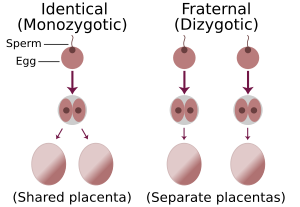Our twins are identical, confirmed through genetic testing. They are monochorionic-diamniotic twins. Basically this means that my body produced one egg that was fertilized. Somewhere in between days 4-8, the egg split, creating identical twins.
Identical or fraternal twins are a result of zygosity. Identical twins are monozygotic, meaning there was one egg that was fertilized and split, creating twins that share DNA. Because identical twins came from the same egg-- which is either male or female-- identical twins are always the same sex. Fraternal twins are dizygotic, meaning there were two eggs that were fertilized. From a genetic standpoint, fraternal twins are essentially siblings that shared a womb.
For our purposes, there are three different kinds of twin pregnancies: dichorionic-diamniotic (di-di), monochorionic-diamniotic (mono-di), and monochorionic-monoamniotic (mono-mono or just monoamniotic). The following picture is not strictly accurate, as there is a small percentage of identical twins that are dichorionic-diamniotic, but it helps convey a basic picture of zygosity.
 |
| Photo courtesy of Wikipedia |
Dichorionic-diamniotic (di-di) twins
For every pregnancy--even singletons--there is an outer sac inside the womb called a chorion. Inside the chorion, is a smaller sac called the amnion, which is what the baby sits inside. Dichorionic-diamniotic twins are each inside their own chorion and their own amnion with separate placentas; there is a thick wall in between the twins during the pregnancy. On an ultrasound, you can clearly see that they are in their own separate sacs.
Most dichorionic-diamniotic twins are fraternal. 75% of twins are dichorionic-diamniotic, making 25% of twins identical. Out of that 25% of identical twins, 30% of those are dichorionic-diamniotic, which is 7.5% of the twin population. This happens when the egg splits between days 1-4.
Monochorionic-diamniotic (mono-di) twins
Monochorionic-diamniotic twins share a chorion and placenta, but have their own amnions. The wall, or membrane, between these twins during pregnancy is much thinner and will move with the twins as they stretch in womb. On an ultrasound, they will look like an egg with two yolks. Monochorionic-diamniotic twins are always identical.
Monochorionic-monoamniotic (mono-mono or monoamniotic) twins
Monochorionic-monoamniotic twins are extremely rare. They are always identical. Out of the 25% of identical twins, 2% of those will be monochorionic-monoamniotic. Monoamniotic means that they share a chorion, amnion, and placenta. Monoamniotic twins are always monochorionic. Inside the womb, they are skin to skin with each other. This type of pregnancy results from the egg splitting late, after day 8. There are a multitude of complications that accompany this type of pregnancy, requiring a lot of specialized care because of the high mortality rate for these type of twins.
 |
| A Monochorionic-monoamniotic twins B Dichorionic-diamniotic twins Photo courtesy of Multiple Pregnancies |
Identical twins do not run in families. The egg splits on its own accord, regardless of whether or not there are other sets of twins, identical or fraternal, in families. Naturally occurring fraternal twins are passed down through families by genetics. A brief lesson in genetics: if a man marries a woman who is a fraternal twin, there is a high chance that she will have fraternal twins. Let's say that she has boy/girl fraternal twins. When they grow up to have children, there is a high chance that the girl fraternal twin will give birth to fraternal twins. On the other hand, when the boy grows up and has children, he cannot pass hyperovulation (a.k.a. the "twin gene") to his wife through, um, intercourse. His children, however, inherited their father's genetics and will have a higher chance of having twins themselves. That being said, if a set of fraternal twins is conceived through fertility treatments, when they grow up to have children, they will not have a higher chance of having multiples because there is no hyperovulation gene in their family.
Higher order multiples are variations of these. One set of triplets may have started from two eggs, one of the eggs splitting, resulting in a set of identical twins and a fraternal sibling. A set of quadruplets may have, again, started from two eggs, each of these eggs splitting, resulting in two sets of identical twins.
Comments